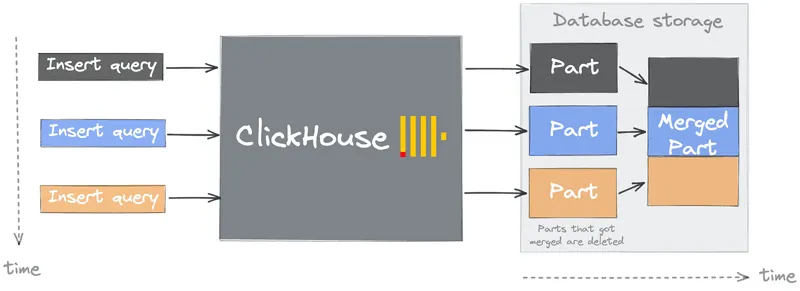Why Datazip chose Clickhouse to provide a managed data warehouse?

Check out OLake, our latest open source offering for replicating databases to lakehouses.
Datazip is on a mission to make data engineering obsolete. Data engineering space is going through massive transformation as need for data engineers is ever growing.
But the amount of data engineers available is not growing with the same space. So we are creating a product which combines ingestion, warehouse, transformation, governance, observability and an optional visualisation layer.
We are getting popular in SME & early enterprise space as this is where the data engineering talent is needed but isn't available.
Why Clickhouse as a warehouse in Datazip?

1. Massively popular open source warehouse:
- Clickhouse has 35k github stars. Including more than 5,000 commits.
- Good & detailed documentation, active slack communities. 50 regular meetups annually in popular tech cities around the globe.
- Most of the questions/how-to's or doubts you will find stackoverflow thread or github issues or can be answered on slack within SLA of 1-2 days.
2. Performance:
- ClickHouse has purely columnar storage, compression, and indexing techniques.
- It has optimised itself for near real-time ingestion where most of popular warehouses lag. In Datazip, you can go as low as 1 min for ingestion frequency to Datazip managed Clickhouse
- In terms of query-performance to cost ratio, Clickhouse shines compared to most other warehouses. Ex, its 2-3x faster than redshift.
- Clickhouse is tuned to perform the best query running time complexities by keeping most of the data in-memory, but this behaviour can be tuned depending on how much ram you intend to use for queries. Giving best flexibility.
3. Use cases :
-
Its an misconception that Clickhouse is not supposed to handle joins better compared to other warehouses, it has support for all popular join algorithms which can be tuned based on performance, RAM usage or Join type support. Read more
-
Its also an misconception that Clickhouse is only for real time use cases and not for the normal or historical data analytics. Its more optimised for real-time analytics but its also well aligned in terms of all historical data analytics.
At Datazip we provide you both vertical and horizontal scaling to make sure your adhoc queries run on large historical data as well with separation of concerns for different workloads.
- Clickhouse supports all popular and needed SQL syntax including window functions, joins, aggregates. Also support Array, Tuple and JSON types.
- In recent versions, Clickhouse syntax has become identical to Mysql syntax around 90% so most of mysql queries should run here.
-
Many people have voiced concerns over that Clickhouse has a default query monitor which kills the query as they occupy a large chunk of memory which goes out of memory.
And there is no way to tweak it. Its WRONG. Clickhouse has many ways to control memory utilisation that we have listed down here. There are many simple ways to decide if query can run at the best time complexity or dump data to disk and trade memory for speed.
-
So all in all, Clickhouse with its recent developments and version have made it a strong contender in warehousing space which is open-source with big community just like most popular data engineering tools like Apache Spark, Presto or Airflow.
About Datazip
Datazip is an AI-powered Data platform as a service, giving the entire data infrastructure from ELT (Ingestion and transformation framework), storage/warehouse to BI in a scalable and reliable manner, making data engineering and analytics teams 2-3x more productive.
Ready to revolutionize your data warehousing strategy? Contact us at [email protected] to learn more about how Datazip can benefit your organization.
FAQ :
1. What distinguishes ClickHouse as the preferred data warehouse solution for SMEs using Datazip?
ClickHouse delivers unmatched query performance and cost efficiency, key for SMEs with limited resources.
An SME could utilize ClickHouse to swiftly analyze multi-regional sales data, thanks to its efficient columnar storage and advanced compression techniques, enhancing decision-making with fewer hardware demands.
2. How does ClickHouse manage real-time data ingestion and ensure high query performance, particularly in comparison to traditional data warehouses?
Optimized for low-latency data ingestion, ClickHouse supports near-real-time scenarios through its columnar storage and asynchronous data writing capabilities.
For example, a logistics operator could use ClickHouse to instantaneously process and analyze GPS tracking data, facilitating dynamic route optimization.
3. Can you detail how Datazip's integration with ClickHouse addresses common misconceptions about its capability to handle complex SQL queries and large datasets?
Datazip amplifies ClickHouse's handling of complex SQL queries with advanced configuration for query optimization.
This makes it feasible to efficiently process large-scale JOIN operations, as seen when merging extensive datasets like user interactions and product inventories to generate immediate insights.
4. What are the specific memory management options in ClickHouse that prevent out-of-memory issues during large-scale operations?
ClickHouse offers robust memory management settings, including tunable memory limits for queries and the ability to spill data to disk during peak loads.
This approach is critical for high-load scenarios, such as financial firms analyzing transactions during market close, ensuring stability and performance
